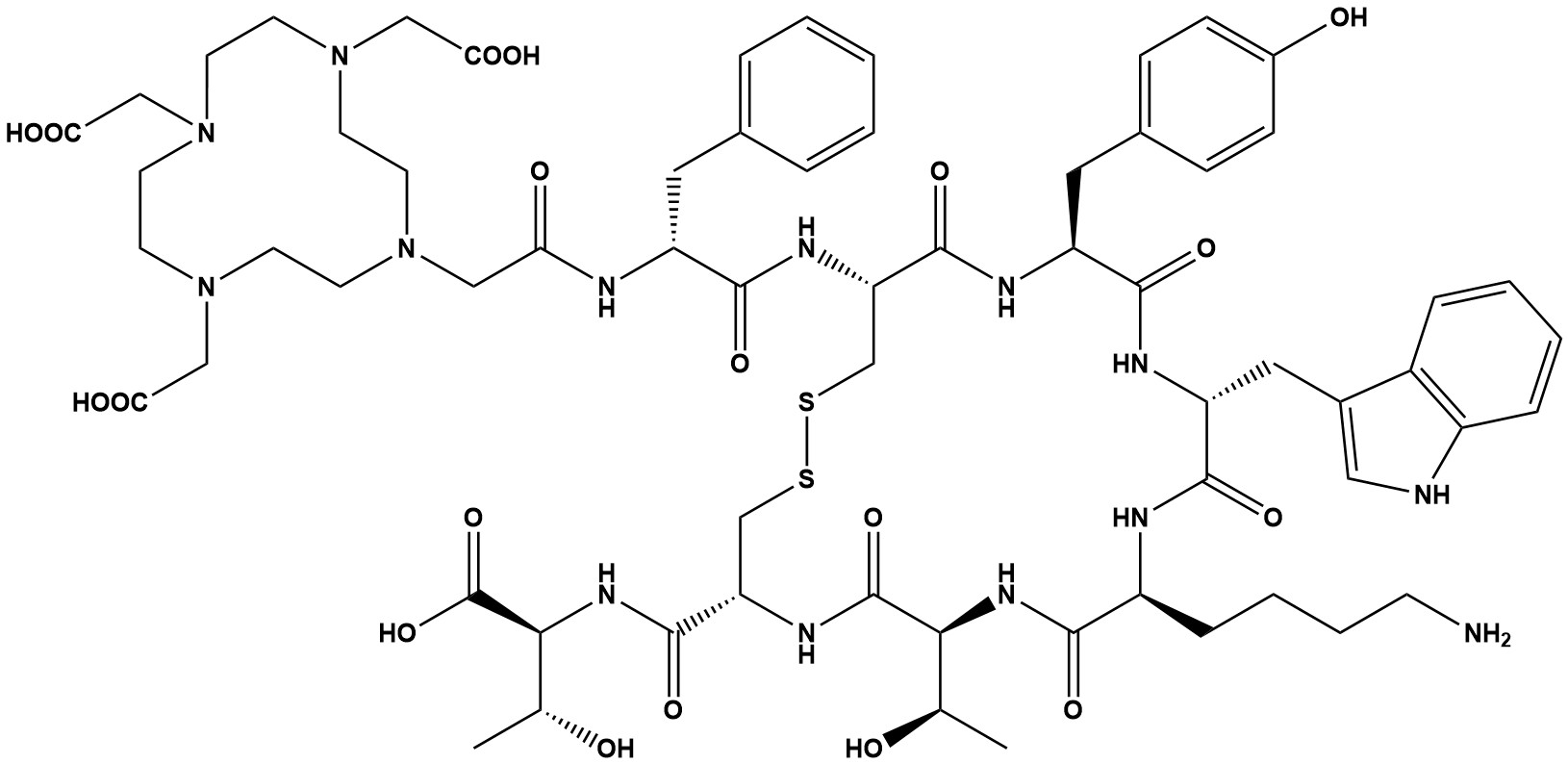| Synonym: | DOTA-(Tyr3)-Octreotate; DOTA-Octreotate; DOTA-D-Phe-Cys-Tyr-D-Trp-Lys-Thr-Cys-Thr (Disulfide bridge:Cys2-Cys7) |
| CAS #: | 177943-88-3 (net) |
| CAS #: | 177943-89-4 (acetate salt) |
| Molecular Formula: | C65H90N14O19S2 |
| Molecular Weight: | 1435.6 |
| DOTA-TATE is a radiopharmaceutical compound used in nuclear medicine, particularly in the diagnosis and treatment of neuroendocrine tumors (NETs). It consists of the chelator DOTA (1,4,7,10-tetraazacyclododecane-1,4,7,10-tetraacetic acid) conjugated to the somatostatin analog TATE (Tyr³-octreotate). This compound is typically labeled with radionuclides such as Gallium-68 (⁶⁸Ga) for diagnostic imaging or Lutetium-177 (¹⁷⁷Lu) for targeted radionuclide therapy. 1. Mechanism of Action DOTA-TATE binds to somatostatin receptors (SSTRs), particularly subtype 2 (SSTR2), which are overexpressed in many neuroendocrine tumors. When labeled with ⁶⁸Ga, it allows for precise imaging of these tumors using positron emission tomography (PET). When labeled with ¹⁷⁷Lu, it delivers targeted radiation to the tumor cells, leading to their destruction while sparing surrounding healthy tissue. 2. Diagnostic Imaging (⁶⁸Ga-DOTA-TATE PET/CT) (1). Indications: Used for the localization and staging of neuroendocrine tumors, including gastroenteropancreatic NETs, pheochromocytomas, paragangliomas, and other SSTR-positive tumors. (2). Advantages: High sensitivity and specificity for detecting primary and metastatic lesions, superior to conventional imaging modalities like CT or MRI. (3). Limitations: Availability of ⁶⁸Ga and the need for a cyclotron or generator for its production. 3. Therapeutic Application (¹⁷⁷Lu-DOTA-TATE) (1). Indications: Used for the treatment of inoperable or metastatic neuroendocrine tumors, particularly those that are SSTR-positive. (2). Advantages: Targeted therapy with reduced side effects compared to traditional chemotherapy. It has shown significant tumor shrinkage and improved progression-free survival in clinical trials. (3). Limitations: Potential renal toxicity due to the radionuclide’s excretion pathway, necessitating renal protective measures. Limited availability and high cost of ¹⁷⁷Lu. 4. Efficacy and Safety (1). Efficacy: Clinical studies have demonstrated that ⁶⁸Ga-DOTA-TATE PET/CT is highly effective in detecting NETs with high sensitivity and specificity. ¹⁷⁷Lu-DOTA-TATE therapy has shown promising results in terms of tumor response rates and patient survival. (2). Safety: Generally well-tolerated, with the most common side effects being mild to moderate nausea, vomiting, and fatigue. Renal toxicity is a concern with ¹⁷⁷Lu-DOTA-TATE, but it can be mitigated with amino acid infusions to protect the kidneys. DOTA-TATE, particularly when labeled with ⁶⁸Ga or ¹⁷⁷Lu, represents a significant advancement in the management of neuroendocrine tumors. Its ability to precisely target and treat SSTR-positive tumors has made it a valuable tool in both diagnostic imaging and therapeutic applications. Despite some limitations related to availability and potential side effects, the benefits of DOTA-TATE in improving patient outcomes are substantial. Ongoing research is focused on optimizing dosing regimens, exploring combination therapies, and developing new radionuclides with improved therapeutic profiles. Additionally, efforts are being made to increase the accessibility of these advanced diagnostic and therapeutic options to a broader patient population. References 1. DOTA-TATE 2. Lutetium-177 DOTATATE: A Practical Review 3. DOTA-TATE – Knowledge and References 4. 177 Lu-DOTA-EB-TATE, a Radiolabeled Analogue of Somatostatin Receptor Type 2, for the Imaging and Treatment of Thyroid Cancer 5. 68 Ga/ 177 Lu-labeled DOTA-TATE shows similar imaging and biodistribution in neuroendocrinetumor model 6. Gallium-68 DOTA-tate – a single center experience developing kit-based dose preparations to support radiotheranostics |
|
DOTA-TATE
For Research & Development use only. Not for testing and/or use on humans.



